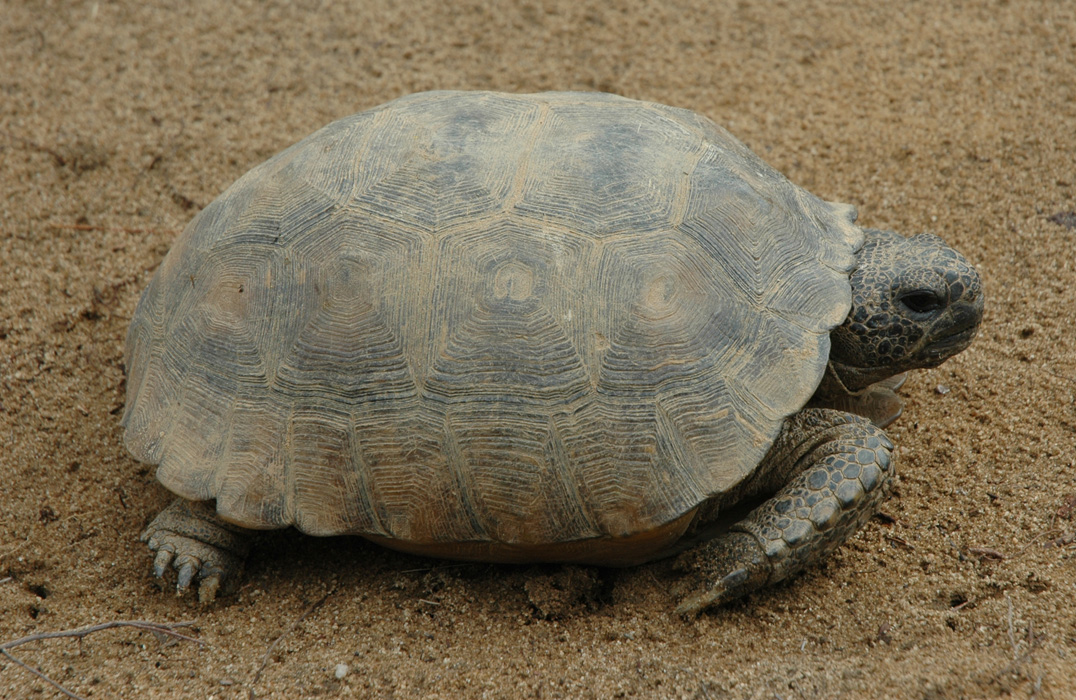Ants collected at Fall Line Sandhills Natural Area, Taylor County, Georgia
Joe A. MacGown and JoVonn G. Hill
Uploaded August 2007
The Fall Line Sandhills Natural Area in Taylor County, Georgia is an 876 acre tract of sandhill habitat that was only recently acquired by the State of Georgia. The fall line sandhills originated in the Miocene Epoch about 25 million years ago when they formed the coastline of the Atlantic Ocean. This site is only a small component of the entire fall line sandhill community, which bisects the entire state. These sandhills are extensive and cross the state from Columbus northeast to Augusta following the fall line, which separates the Piedmont region from the Coastal Plain. Historically, this area was most likely a mix of oak/pine dune scrub and longleaf pine (Pinus palustris) forests, which were dominated by wiregrass (Aristida stricta) and a myriad of other understory species. However, periodic burns are required for longleaf pine forests to flourish, with the result that only few of these pines are still present today. More recently, much of the property was planted with loblolly pines (Pinus taeda), which have not faired well at all due to the deep sand. Along the western edge of the property is an open swath that was created by a powerline cut. Vegetation on the powerline cut included Rubus sp., Opuntia sp., risky tread softly (Cnidoscolus stimulosus), wiregrass, and a variety of other grasses and forbs. Small pockets of oak scrub are still present and are dominated by turkey oak (Quercus laevis), bluejack oak (Q. incana), dwarf post oak (Q. margaretta), loblolly pine, Rubus sp., wiregrass (Aristida beyrichiana), and an abundance of other plants present as well such as persimmon (Diospyros virginiana), Vaccinium sp., Opuntia sp., little bluestem (Schizachyrium scoparium), risky tread softly, and other species. In addition to the typical sandhill flora and fauna, 11 species of concern are known to occur at the site including 8 animals and 3 plants, making this a unique area and an ideal study site for insects as well.
Sandhill and otherwise sand-rich habitats in Florida have been documented to have highly diverse ant faunas (Lubertazzi and Tschinkel 2005, Van Fleet 1958). Although some recent work has been done documenting the ant fauna of the Fall Line Sandhills in Georgia (Graham et al. 2004), there has been little study of other sandhill habitats in the state. Graham et al's. research was mostly limited to the Fort Benning area in Chattahoochee County and included a variety of habitat types. The only comprehensive study of ants of Georgia (Ipser et al. 2004) was limited to ground dwelling species. Our objective was to survey the ant fauna of the Fall Line Sandhills Natural Area in Taylor Co and to compare it to that of Ohoopee Dunes Natural Area in Taylor Co., GA (Ohoopee Dunes ants) and Big Hammock Natural Area in Tattnall Co., GA (Big Hammock ants). Our collections were made at seven different sites within the natural area (see Sites below for lat/long and habitat descriptions). Collections were made on three separate occasions: 14-15 May 2007, 16-17 July 2007, and 5 October 2007. All collections were made by Joe MacGown and JoVonn Hill by a variety of methods including general collecting, baiting, litter sampling, and blacklighting.
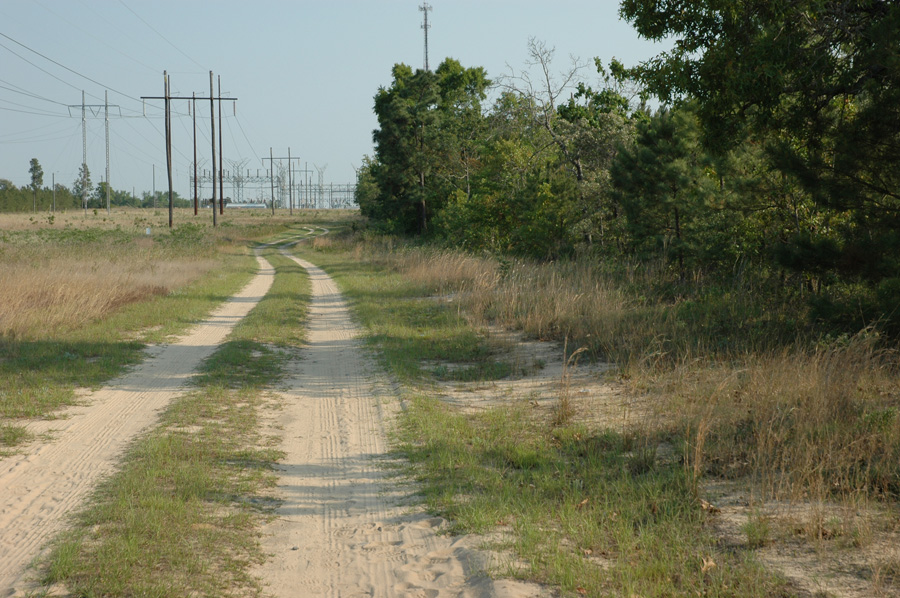
Site 1 at the Fall Line Sandhills Natural Area.
On our first visit to the Fall Line Sandhills on 14 May 2007, we arrived late in the day. Before we began our collections, we drove along the perimeter and interior sand "roads" to get a feel for the place. After our initial scouting foray we decided to start our collections near the southwest area of the property between the powerline cut and a turkey oak scrub forest at site 1 (32°34'37"N84°17'25"W). In part, we based our decision to begin our collecting at that locality because of the proliferation of Trachymyrmex septentrionalis McCook, Dorymyrmex spp., and harvester ant (Pogonomyrmex badius Latreille) colonies that we observed while driving down the road. The entire area was quite disturbed as a result of the powerline cut being regularly mowed or sprayed with herbicide, the fact that a road (albeit a sand road) bisected it, and from the somewhat ambitious undertaking of a prior owner of the site having planted loblolly pines in the deep sand. Typically, disturbed habitats support somewhat meager assemblages of native ants, and an abundance of a few exotic species. However, sandhill habitats, with their deep sand systems, usually manage to hold on to many of the native species that appear to be adapted for life in such harsh environments, whereas in many cases exotic species do not completely inundate such habitats. This appeared to be the case at site 1 and the Fall Line Sandhills N. A. in general, and we noted many of the typical species associated with sandy habitats, and although we found five exotic species in total in the natural area, they were not found in overwhelmingly large numbers.
As we collected along the edges of the roadside, in open areas in the oak scrub, and in the mostly open powerline cut area, we found many large colonies of P. badius, the Florida harvester ant. This very interesting polymorphic ant is the only species of the genus to occur east of the Mississippi River and is restricted to areas of deep sand. Harvester ants are among the group of ants that are active during the heat of the day. At night they close the entrance holes to their subterranean colonial world. Although harvester ant colonies may extend 3 m or more in depth, excavating the top 4 to 5 cm of soil from mounds revealed the presence of brood. This granivorous species is susceptible to disturbance, and especially various insecticides, but still manages to exist in suitable habitats. In fact, sometimes the right type of disturbance may actually open up or create habitat for this species. Abundant populations of the introduced fire ant, Solenopsis invicta Buren, may also have a negative impact on P. badius populations, especially on a small scale. Fire ants are not the only insect threat to this species. While we were there we observed a reduviid bug eating a harvester ant worker. After it finished eating an ant, it attempted to grab another, but subsequent attempts were thwarted by the attacks of multiple ants. Eventually, the reduviid evaded the attacks of the ants and flew away.
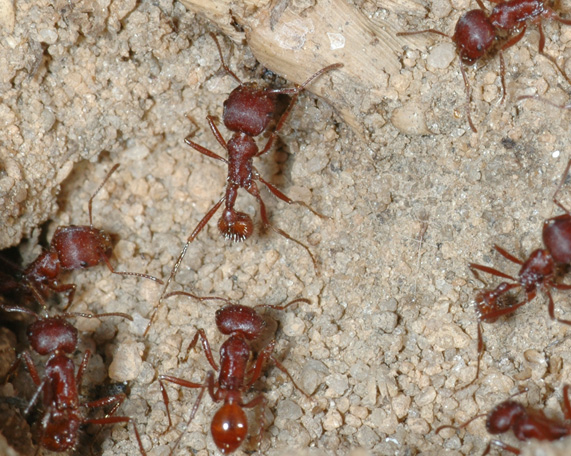
Harvester ant workers exiting a nest.
Colonies of the fungus growing ant, Trachymyrmex septentrionalis, were extremely abundant, and their distinctive cresentic mounds dotted the landscape. We regularly find this species in a wide variety of habitats, but they tend to be more abundant in sandy areas. This is another species that can tolerate, and indeed, flourish in habitats with the type of disturbance as was in evidence at the natural area. This species is related to the well known leaf cutting ants in the genus Atta, and similarly, they also cut leaves, which they use in part as a substrate to grow their fungus on. However, they also rely on insect feces and various other plant and animal detritus for their substrate. While we were here, we observed workers carrying both insect feces and bits of leaves into their colonies. For the most part, this species is active during cooler periods of the day from near dusk through early morning, but workers may also be seen foraging during mid-day if temperatures are low or there is sufficient cloud cover.
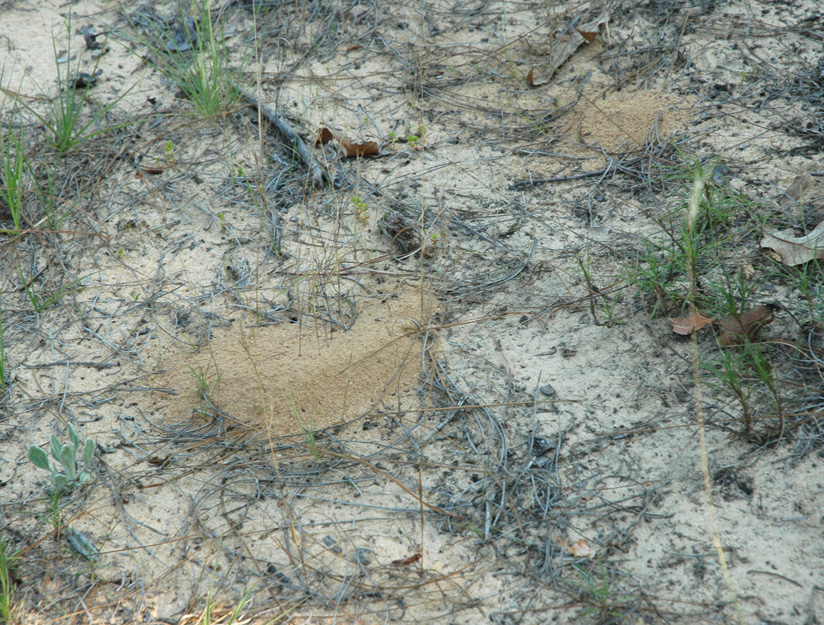
The distinctive mound of a Trachymyrmex septentrionalis colony
Colonies of two species of Dorymyrmex, D. bureni (Trager) and D. smithi Cole, were seen in comparable numbers to that of Trachymyrmex. Both of these species tend to nest along roadsides, in fields, pastures, and other open areas, especially in sandy soils, in the Southeast. Similar to P. badius and T. septentrionalis, these species also thrive in disturbed, open, sandy environments. At this site, we noticed that D. smithi were much more abundant than D. bureni in the most disturbed areas, whereas D. bureni were more abundant in the less disturbed sites. Both of these species typically have somewhat conical mounds surmounting their subterranean nests. They are long-legged, fast moving ants that are active during the day. Like other members of the subfamily Dolichoderinae, they lack stingers, but rely on potent chemicals for defense. It is not unusual to find the edges of their mounds littered the dead bodies of fire ants that they have killed. The two are very different in appearance as D. bureni is typically yellow to yellowish-brown and has an evenly convex mesonotal profile without an obvious declivity posteriorly, whereas D. smithi is reddish-brown to brownish-black and has an angular mesonotal profile with distinct dorsal and declivous faces. It is thought that D. smithi is a temporary parasite of D. bureni, and it is not unusual to find these species nesting together, or occasionally, even in the same colony (Trager, 1988). Some taxonomists refer to D. smithi as D. medeis Trager, although this name was synonymized by Snelling in 1995. This group shows much in the way of variation, and it is likely that it will receive further taxonomic work in the future.

Dorymyrmex smithi workers carving up a grasshopper.
Colonies of another dolichoderine ant, Forelius pruinosus (Roger), were common at site one. Like many dolichoderines, this somewhat small, dark brownish-black ant is also mostly active during the day, and it is not unusual to see foragers scurrying about at peak temperature periods. This species typically has slightly conical mounds with a large single entrance hole above its subterranean nest. Queens are much larger than workers and are bicolored reddish-orange with a dark brown gaster. This species, along with Dorymyrmex species, are usually only found in sandy habitats, similar to the Fall Line Sandhills area.
Colonies of the minute exotic "dark rover ant", Brachymyrmex patagonicus Mayr, were found throughout the oak scrub area nesting at bases of plants and in rotting pieces of wood. This species is in the subfamily Formicinae and is related to carpenter ants, but is much smaller and consequently, less noticed by the casual observer. Although this species was only first reported as occurring in the U.S. in 1976, it is now widespread and abundant in the southeastern region (MacGown et al. 2007). It thrives in disturbed areas, but we have also collected it in more natural habitats. Two other species in the same subfamily, Nylanderia arenivaga (Wheeler) and Camponotus decipiens Emery, were collected at site 1. The first species, N. arenivaga, is a yellow colored ant that nests in sand. Colonies are marked by a thin ring of soil approximately six cm in diameter that surrounds the single entrance hole to the subterranean colonies. Nests are relatively deep and it is sometimes difficult to find workers during the day without serious excavation. However, workers of this species are very active at night and are much easier to collect then. Colonies of N. arenivaga were abundant at the site. Camponotus decipiens is a small carpenter ant that typically nests in small pieces of rotting wood or cavities of twigs, galls, or other suitable sites. This species is bicolored with a reddish body and appendages and a black gaster. Only one dealate queen and one worker were collected from this site, and they were found in leaf litter beneath Vaccinium sp.
Hypoponera opacior (Forel), a small, brown, widespread litter-inhabiting ant, was the only ponerine collected at the site, although others in that and related subfamilies were potentially present as well. In addition to H. opacior, three other species, Strumigenys louisianae Roger, Aphaenogaster carolinensis Wheeler, and Myrmecina americana were collected in litter in the oak scrub area, the latter three of which belong to the subfamily Myrmicinae. These are all very common and widespread ants that are known to occur in a variety of habitats. Strumigenys louisianae is a minute dacetine ant that possesses elongate mandibles, which it uses as it preys upon select species of Collembola and other minute organisms. Aphaenogaster carolinensis is an average sized, reddish-brown species with pale yellow legs that typically nests in somewhat small colonies in soil, or sometimes in rotting wood. Myrmecina americana is a small, ubiquitous species in the southeastern U.S. that nests in soil beneath rotting wood or at bases of trees. This black colored species is distinctive with its characteristic sharp carina found along the ventrolateral margin of the head, sessile petiole, and bispinose propodeum. These characters will easily distinguish this species from other ants found in this region. When threatened, we have observed this species to curl up and remain motionless for short periods of time.
Only one other species, Solenopsis invicta Buren, the introduced red fire ant, was collected at site 1. This exotic species, originally from South America, has become one of the most reviled insect pests in the Southeast. Similar to B. patagonicus, it also thrives in disturbed areas, especially open areas. At one time it was thought that this species out competed many native species for resources. However, more recently it has been shown that it may have much less of an impact than originally thought, with the exception of Solenopsis geminata and S. xyloni, which basically filled the same ecological niche and apparently were greatly affected by the imported species. Fortunately, S. invicta does not appear to flourish in habitats with deep sand, and indeed that was the case at site 1. Although many colonies were discovered at the site, there was not nearly the abundance as we have seen in many other disturbed habitats. This species often forms large mounds. Workers are bicolored reddish brown with a black gaster. This species is aggressive and has a potent sting.
The following day, 15 May 2007, we made collections at three more sites with the Natural Area. The first site, site 2, was located further north from site 1 down the same sandy road at 32°35'03"N84°17'28"W. The habitat was very similar at to site 1, except for subtle differences in the oak scrub area. Along the road, there appeared to be more plant diversity and relatively thick undergrowth, whereas the area just west was primarily planted in young loblolly pines on furrowed land, with various low growing vegetation. Due to the similar nature of the habitat as compared with the first site (and much of the area in general) we noted many of the same species at site 2 as we saw at site 1 including D. bureni, D. smithi, F. pruinosus, B. patagonicus, N. arenivaga, T. septentrionalis, S. invicta, P. badius, and A. carolinensis. The areas on the raised furrows between pines provided suitable habitat for P. badius, and we noted many colonies. Other species collected at the first site were likely here as well, although they were not collected. Additionally, we collected several other species not found at site 1 including Nylanderia vividula (Nylander), Formica dolosa Buren, Strumigenys membranifera Emery, Solenopsis carolinensis Forel, and S. pergandei Forel.
Individuals of D. smithi that we collected nesting in the oak scrub away from the sandy road tended to be slightly larger than those found along the road itself. Our initial thoughts were that the smaller specimens were D. grandulus (Forel), a smallish, dark brown species. However, after subsequent examination under the microscope, they appeared to be smaller workers of D. smithi. Nylanderia vividula is a widespread species that is usually found in somewhat open habitats at bases of trees, logs, or under objects, or in urban areas at edges of houses, sidewalks, etc. This species is brownish in color and more active diurnally. There is some question as to whether or not this species is exotic or native in the U.S., but either way, it is sometimes very common in certain areas and is considered a nuisance pest. Workers of Formica dolosa, another formicine ant, were found as they crawled on the ground in the scrub. Although workers were observed for a while, their colony was not discovered. This large reddish-brown species is typically found in open forested areas.
The collection of the exotic S. membranifera in this habitat was not surprising, as we routinely have found this species in similar sandy habitats throughout the Southeast, although it is not confined to sandy areas, and can be found in many disturbed areas. This is a minute species that is found in soil and litter, and seems to be especially common at bases of grass clumps. Solenopsis carolinensis is a tiny yellowish orange ant that is found in soil and litter, or under bark. This is a particularly problematic species group and it is difficult to accurately assign a name to some species unless queens are present, and even then it is difficult. The other species in the group collected at site 2, S. pergandei, is bigger, paler in color (whitish-yellow), and has a more circular postpetiole. This species typically only nests in sand.
After collecting at site 2 for a couple of hours, we moved on to site 3, which was found along a road in the north central part of the natural area at 32°34'51"N84°16'49"W. This site was different from the first two in that there was no appreciable oak scrub present (at least in the natural area; there was plenty on the privately owned land on the north side of the road) and there were some large long leaf pines present. Most of the area was planted in planted loblolly pines (young plantation), with some dwarf post oak, Crataegus sp., wire grass, Rubus sp., and other species. We only stopped at this site briefly, and collected two gallon bags with sifted leaf litter and did additional general collecting.
We found workers of a recently described species of Crematogaster, C. pinicola Deyrup and Cover, crawling on the longleaf pines. This bicolored red and black species is most similar to C. ashmeadi Mayr and is still considered by some researchers to actually be that species. On the ground we noted the presence of T. septentrionalis and S. invicta colonies. Brachymyrmex patagonicus was also found nesting in the area. Workers of Formica pallidefulva Latreille, were found crawling on the ground. This species is often found in fields or open wooded areas. It is similar in coloration to F. dolosa, being a orangish-red, but differs in that it has much less pilosity on the alitrunk. A colony of Cyphomyrmex rimosus, in the Attini tribe, was found in the soil. This exotic species is related to T. septentrionalis, and is common in the coastal plain of the southeastern U.S. Colonies tend to be small, and workers are blackish and have blunt knobby projections on the alitrunk, as compared with T. septentrionalis, which are reddish-brown and have irregularly pronged projections. We also found H. opacior, Strumigenys ornata Mayr, and M. americana in the leaf litter. Strumigenys ornata is a wide spread native species that is easily distinguished from related species by its having "lollipop" shaped setae that arise from the sides of the clypeus in a fan shape (this is a minute ant and you need a microscope to adequately view the unique hairs).
We continued down the sandy road eastward approximately 0.125 mile and then turned south where we stopped after approximately 0.2 miles at site 4 (32°34'37"N84°16'24"W). This area appeared to have some more natural looking elements and we thought it looked good for ant collecting. Heading in a northwest direction through some pines we entered an open grassy/sandy area with lots of wire grass, cactus, Crataegus sp., wire grass, Rubus sp., Vaccinium sp. (in bloom), and the presence of several gopher tortoises. Bounding this general area to the north was a large stand of older loblolly pines, with a nice litter layer.
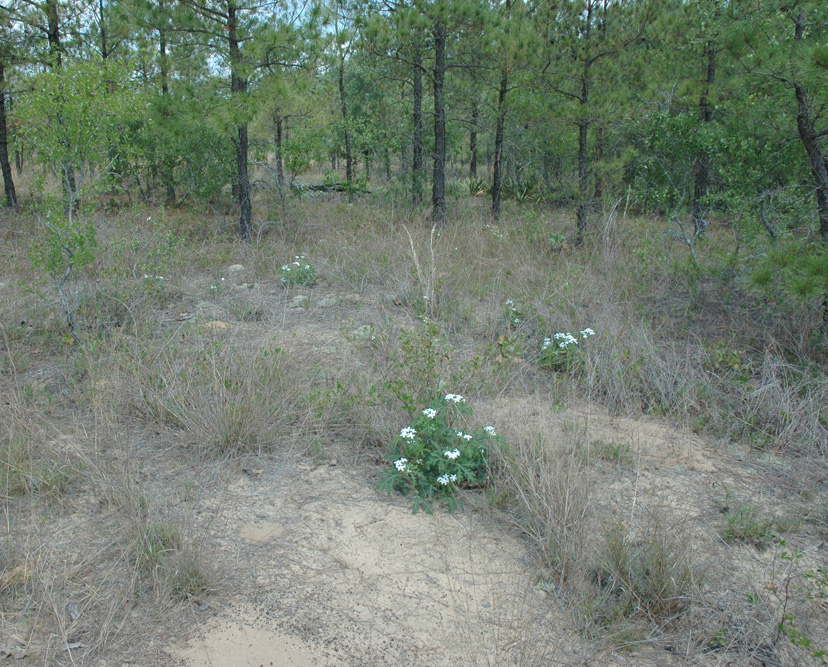
Site 4, showing grassy area south of loblolly stand
Not surprisingly, we found a similar ant fauna in the open sandy habitat with an abundance of D. bureni, D. smithi, T. septentrionalis, and P. badius colonies. Both B. patagonicus and S. invicta, were also at the site, although not in overwhelming numbers. Searching the pine litter we found N. vividula, Ponera pennsylvanica Buckley, Strumigenys ornata , S. carolinensis, Aphaenogaster carolinensis, A. fulva Roger, Pheidole adrianoi Naves, P. dentata, Temnothorax curvispinosus Mayr, and Myrmecina americana. Ponera pennsylvanica is a small brown ponerine ant that is very similar in appearance to H. opacior, but differs in that its petiole is wider apically (about the same width as base, as seen in side view) and the petiole has a ventral process with a translucent, circular window and two teeth that point posteriorly. One of the A. carolinensis workers collected was smaller and darker than is typical and it is possible this was another form or species. Members of this group are very difficult to identify and there are apparently several undescribed species involved. However, for the sake of convenience, we are simply referring to the specimens collected at the natural area as A. carolinensis at this time. An additional related species, A. fulva, was collected in the same area. This species is dark brown (including the legs) with relatively long propodeal spines that are directed upward (more upward than in A. carolinensis). Pheidole adrianoi is a small black species that is known to occur in habitats with sandy soils. This species does not seem to be extremely widespread and may be confined to select habitats in the coastal plain. Conversely, P. dentata is a widespread species that occurs in many different habitats. It typically has large nests in rotting wood, or occasionally in the soil. Similarly, T. curvispinosus is widespread, although it usually has smaller nests in hollow stems or various plant cavities. Workers are tiny, yellow, and have long, somewhat curved propodeal spines.
We made a second visit to the Fall Line Sandhill N. A. on 16 July 2007, again arriving late in the day at approximately 4:00 P.M. As is typical for this time of year, temperatures were in the upper 90's (F), with a heat index of over 100° F. Similar to our first visit in May, we began our collections at site 1, to see if there were any obvious differences in the ant fauna. Not surprisingly, we once again found the same species to be proliferating at the site. We again observed many colonies of P. badius, especially in the open powerline area; incredibly large numbers of D. smithi workers patrolling the area; N. arenivaga craters; and numerous T. septentrionalis mounds in evidence. Workers of the latter two species were not noted, as they are not typically active during the day, especially when temperatures are high. However, alate males of Trachymyrmex were collected in litter. The males are similar to workers and queens, but are much darker and have dusky blackish colored wings. Although we observed many colonies of D. bureni scattered throughout the area, they were not nearly as abundant as the D. smithi colonies. We again found colonies of the fire ants, S. invicta, but not in high numbers. We noted the presence of numerous dealate fire ant queens crawling on the ground; however, the ever-voracious D. smithi workers were quickly killing them.
Searching at bases of plants, under bark, and in dead-fall wood in the pine-oak scrub, we again found many colonies of B. patagonicus. Workers of the dacetine ant, S. louisianae, were again found in the leaf litter in the scrub area. Two species, N. vividula and A. fulva, which were collected at the natural area during the last visit, but not at site 1, were collected in litter at the base of a turkey oak. Only two species, H. opacior and A. carolinensis that were found during the first collecting trip were not found on this outing at site 1, but it is likely that those species were still present, as they are very common and they can typically be found throughout much of the year in this region. Individuals of the introduced tenebrionid beetle, Poecilocrypticus formicophilus Gebien, thought to be associated with imported fire ants were found crawling on the ground in the open powerline cut area. This species appears to be mimicking the spread of the fire ants, and are thought to be scavengers. They may also be associated with other ant species (MacGown, 2005).
We collected for approximately an 1.5 hours at site 1, then we went to a new collecting site (site 5) in the central part of the natural area (32°34'37"N84°16'24"W). Site 5 was predominately a young loblolly pine plantation, with scattered bluejack oak, turkey oak, and sand pine, especially at the edges. Similar to site 1, D. smithi colonies and foraging workers were unbelievably abundant, and were observed crawling on the ground and vegetation. Several colonies of D. bureni were also evident, but they were by far less abundant. A colony of F. dolosa was discovered in a somewhat open, trail-like area after following workers for approximately 1.0 meter. The colony was entirely subterranean and only marked by a semi-circular opening approximately 1.0 cm in longest diameter. Workers of D. smithi were observed freely entering and exiting the colony. The colony was excavated and searched for myrmecophiles and alates, but none were found. A chamber containing F. dolosa pupae was found approximately 0.5 m deep. Also similar to other sites in the natural area, many colonies of B. patagonicus, P. badius, and T. septentrionalis were found at the site. We also observed several gopher tortoise burrows.
After searching for ants (and grasshoppers and other interesting things) until near dark, we headed back to Columbus (GA) for some food and sleep. We returned to the natural area the next morning and began our collections at site 6 (
32°34'21"N84°16'27"W) at about 9:30 A.M. The habitat at the site was similar to that found at site 5 in that it was basically a planted loblolly forest, but the trees were taller-approximately 9 m (30 ft) in height. The understory was relatively open, but with plenty of Rubus sp., Lespedeza sp., Erigeron sp., Cnidoscolus stimulosus, Panicum sp., Opuntia humifusa, Yucca sp., Myrica cerifera (L.) (wax myrtle), Eupatorium capilifolium, and young Diospyros virginiana (persimmon) along the sandy road at the edge of the site.
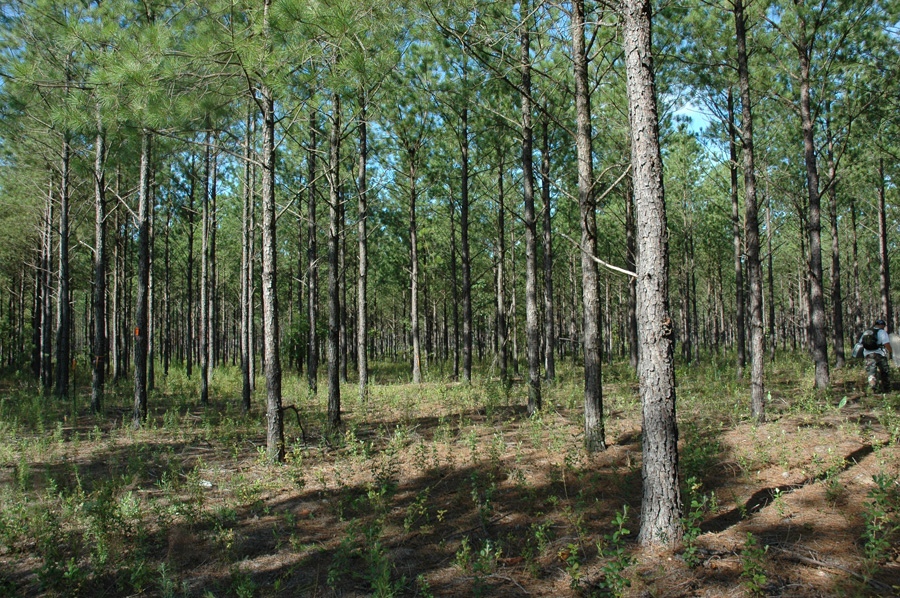
Site 6
Site 6 differed from the other sites in that we did not notice any D. smithi or P. badius colonies. This was not surprising because there were no large open areas of sand at the area at site 6, other than on the sand road itself, and these species prefer open sand habitat. We confined our searches to the wooded region. Fire ants were abundant at this site and were found nesting in the ground, sometimes with irregular mounds, sometimes lacking mounds and instead with nest entrances covered by the pine straw, or in other cases nesting in rotting wood. The exotic B. patagonicus were present in seemingly equal numbers numbers to the fire ants and were found nesting in soil, rotting wood on the ground, and in dead branches still on the pine trees. A few colonies of D. bureni were found scattered throughout the area. Individuals of F. dolosa were found, although no colonies were discovered. A dealate queen of Camponotus nearcticus was collected from a small hole in the ground, but no workers were seen. This was a new species for the natural area, and is typically associated with woodland habitats. This species of carpenter ant belongs to the Myrmentoma subgenus, whose members are relatively small compared to the large carpenter ants. This species is shiny black with little pubescence on the body. Under bark and crawling on the pine trees, the red and black, and only recently described Crematogaster pinicola Deyrup and Cover were abundant. We also found a dealate Crematogaster queen in a pine branch on the ground, although we could not be certain if it was the same species.
Searching in and under leaf litter (mostly pine needles) yielded Hypoponera opacior, Aphaenogaster fulva, Pheidole dentigula Smith, and Myrmecina americana, all of which are associated with rotting wood and leaf litter. Alate males of M. americana were also present. The collection of P. dentigula represented a new species for the natural area. This small Pheidole species is reddish-brown and is typically found in leaf litter at bases of trees or beside and beneath rotting logs. Cyphomyrmex rimosus workers were found beneath the litter layer, although no colonies were found. Three dacetine species, Strumigenys ornata , S. rostrata Emery, and Strumigenys louisianae were collected in litter found beneath a group of wax myrtle trees. These are all very common and widespread species in woodland habitats. This was the first collection of S. rostrata for the area. Three gallon-size bags of leaf litter were collected for Berlese funnel extraction. Several species that we collected by hand were in the samples, as well as one additional species, Brachymyrmex depilis Emery, which was new for the natural area. This minute, pale yellow, soft-bodied species is common in some forested habitats, although surprisingly absent from some flatwoods habitats. One individual of Pseudomyrmex pallidus (Smith) was found on vegetation on the sandy road bordering the site. This was another species that we did not collect on our previous trip to the area. This thin, elongate, yellow species has extremely large compound eyes, and is quite distinctive compared to any other genus of ants in this part of the country. They nest in hollow stems of various plants including larger species of grasses.
After collecting at site 6 for approximately 3 hours, we continued down the sandy road until reaching our final collecting destination for the day at site 7 (32°34'41"N84°16'59"W). This site was another open pine forest/sandhill habitat (mostly loblolly, some sand pine) with one large southern red oak (Quercus falcata Michx.), and lots of undergrowth including such plants as Yucca sp., Eupatorium sp., Vitis sp., Houstonia sp. (or Hedyotis), Rubus sp., young hickory trees, two Smilax species, Silphium sp., Clitoria mariana L. and various grasses.
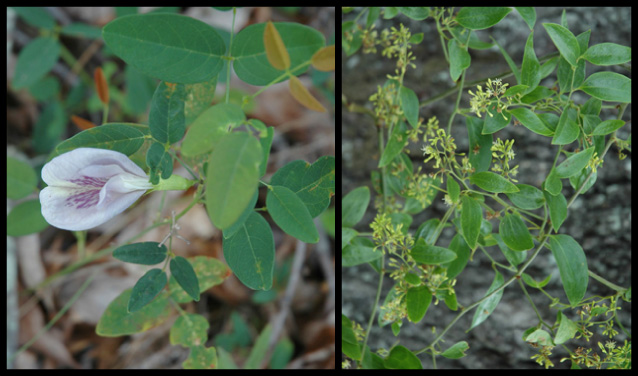
Clitoria mariana (left) and Smilax sp. (right)
We confined our collecting at site 7 to the area just around and including the oak tree. We have had great success collecting many species at similar sized oaks, which sometimes provide habitat for many species (MacGown and Brown, 2006), especially when somewhat isolated as this one was. However, we only collected 5 species at the tree area including Nylanderia vividula, Camponotus decipiens, Pseudomyrmex pallidus, Hypoponera opacior, and Cyphomyrmex rimosus. Nylanderia vividula was found nesting at the base of the tree; Camponotus decipiens workers were found crawling on the tree; P. pallidus was found on a branch of the tree; and H. opacior and C. rimosus were both found in litter at the base of the tree. We also collected two bags of litter from the base of the tree for Berlese funnel extraction. Unfortunately, no ants were found in the samples, and it is possible that the samples may have become overheated, killing the ants, before we got back to the laboratory. Colonies of both D. bureni and T. septentrionalis were observed along the sandy road and road edges that bordered the site, although they were not collected.

A view of the southern red oak at site 7 (with JoVonn ready to collect)
We made our final trip to the Fall Line Sandhills N. A. on 5 October 2007. This particular trip was shortened because we were en route to George L. Smith State Park in Emanuel County to meet some fellow collectors for our annual William H. Cross Expedition. In fact, we only had time to collect for a couple of hours, and we confined our collecting to sites 1 and 4. Upon our arrival to the natural area, we were immediately struck by a profusion of floral color, which included the sandhill golden aster (Pityopsis pinifolia), blazing star (Liatris sp.), false falseglove (Agalinus sp.), and numerous other wildflowers.
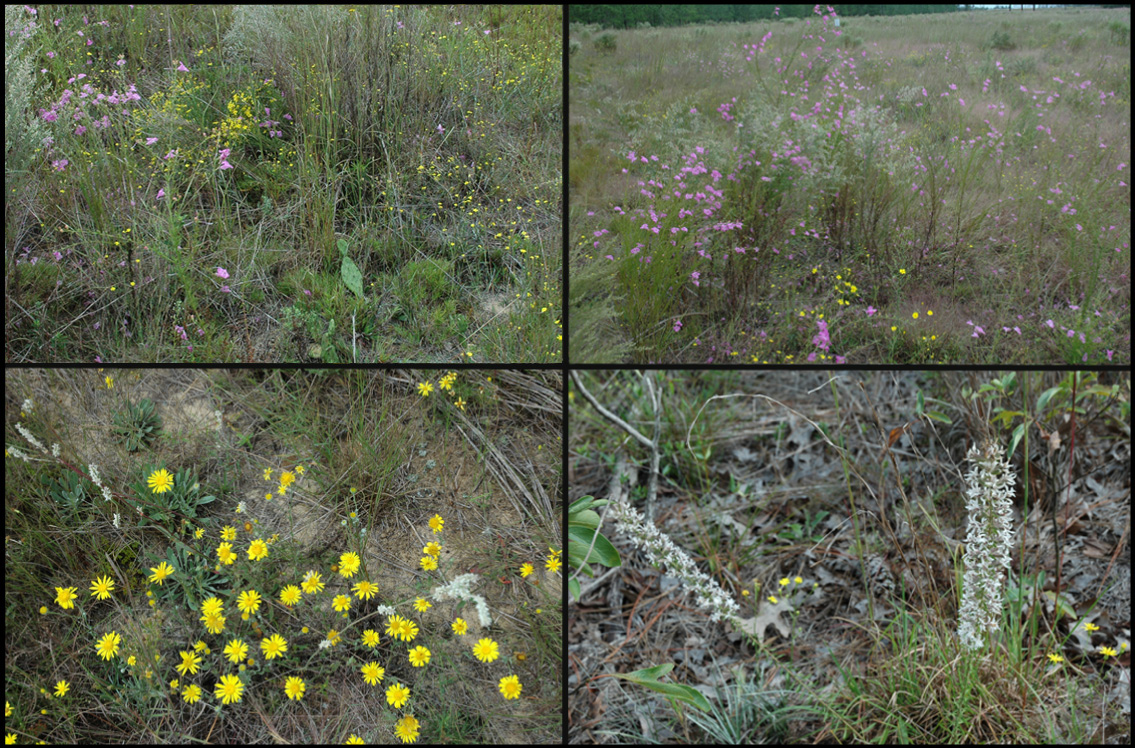
Flowers on the powerline cut at site 1
We arrived at the sandhills at approximately 3:00 P.M. with the sky cloudy and the temperature in the mid 80's F. Due to time constraints and because we had collected there twice already, we only collected minimally. Instead, we primarily observed the ants, again noting the dominant presence of D. smithi throughout the area. The harvester ants were still quite active, and we again noted the presence of several colonies. Similarly, we observed many colonies of T. septentrionalis, although workers were not seen. Fire ants appeared to be more widespread in the area than on the two previous trips. In general, the same group of species was found at the site, with the exception of Aphaenogaster floridana Smith, which we had not previously found. This species is distinctive compared to other southeastern species in the genus in that it lacks propodeal spines. It was a species we were hoping to pick up at the site, as it is typically a relatively common species in sandhill habitats. After collecting for about an hour at our first stop (site 1), we headed to site 4, where we briefly collected. Along the way, we met a gopher tortoise, who was walking down the middle of the sand road. Similar to site1, D. smithi and P. badius were the dominant ants at site 4, although there was also a multitude of T. septentrionalis colonies present. We did not conduct extensive searches for ants on this particular trip, but rather, concentrated on collecting grasshoppers and other insects.
On 14 and 15 May 2007 we collected a total of 27 species at the Fall Line Sandhill N. A., four of which were exotic (five counting N. vividula, which is questionably exotic) and one additional species for the area, Pheidole tetra. On 16-17 July 2007 we collected 23 species of ants, including five new species for the natural area: Brachymyrmex depilis, Camponotus nearcticus, Pseudomyrmex pallidus, Strumigenys rostrata , and Pheidole dentigula (all of which are relatively common and widespread species). Only additional species, A. floridana, was collected for the natural area on 5 October, which increased the total for the natural area to 33. Eight of the species collected at the natural area are indicative of sandy habitats, and included Dorymyrmex bureni, D. smithi, Forelius pruinosus, Nylanderia arenivaga, Solenopsis pergandei, Pogonomyrmex badius, Aphaenogaster floridana, and Pheidole adrianoi. However, there were many species missing from the list that might have been expected, and it is likely that if they were there originally, disturbance may have played a role in their disappearance. Although Dorymyrmex bureni, D. smithi, T. septentrionalis, and P. badius are considered to be sand inhabiting species, they are also species that appear to withstand, and indeed, thrive in disturbed habitats. Therefore, their presence and great abundance at the natural area was a mixed blessing. For example, we generally only find populations of D. smithi in sand habitats that have been highly disturbed. In the case of P. badius, it may be more a factor of suitable habitat, with disturbance having created the open habitat that this species needs. Similarly, the presence of the introduced species in this habitat are also indicators of disturbance, and are not typically associated with less disturbed, more natural sandhill habitats. The remaining species are generalists that may be found in a wide variety of habitats, especially if trees or rotting wood are present.
The collection of 34 species from the Fall Line Sandhills N. A. was comparable to the 25 species we collected at Big Hammock N. A. in Tattnall Co., but fell far short of the 76 species collected at Ohoopee Dunes in Emanuel County. This was not surprising, as the Ohoopee Dunes area is much more extensive, has been much less disturbed by heavy equipment, and we made more collections there. However, no rare, undescribed, or endemic species were found at the Fall Line Sandhills, and overall the array of species found there was indicative of many sandy habitats in the Southeast. We did collect Pheidole tetra, a new state record for GA, at the Fall LInes Sandhills. Although this species had not been reported from the state, it is not particularly rare in general. We did not collect it at the other sandhill sites. The Fall Line Sandhills N. A. had 15 species in common with the Ohoopee sites that were not collected at Big Hammock including D. bureni, D. smithi, B. depilis, B. patagonicus, F. dolosa, F. pallidefulva, P. pennsylvanica, Py. rostrata, S. louisianae, P. badius, A. carolinensis, A. fulva, P. dentigula, C. pinicola, and T. curvispinosus. All three sites (Fall Line Sandhills, Ohoopee, and Big Hammock) shared the following 12 species: F. pruinosus, H. opacior, S. ornata, C. rimosus, T. septentrionalis, S. carolinensis, S. invicta, S. pergandei, A. floridana, P. adrianoi, P. dentata, and M. americana. No species were shared with Big Hammock that were not also found at Ohoopee. The 33 species collected at the Fall Line Sandhills N. A. on only three occasions by general collecting compared favorably to the results of a four year study done of the ants of the Fall Line Sandhills at Fort Benning, Georgia by Graham et al. (2004a), which documented 48 species. However, their study was more comprehensive in scope and included a variety of habitats, some of which were much less disturbed. Overall, their findings were remarkably similar to ours with the same species being abundant in the sandhills habitats, especially D. smith in disturbed areas. To compare the species of ants from Fall Line Sandhills to other localities with similar habitats, click on the links below under the heading "links to ants of other sandhill or sand dune habitats".
Formicidae List (arranged alphabetically by genus)
Aphaenogaster carolinensis Wheeler (sites 1, 2, 4)
Aphaenogaster floridana Smith (Site 1)
Aphaenogaster fulva Roger (site 1, 4, 6)
Brachymyrmex depilis Emery (site 6)
Brachymyrmex patagonicus Mayr (sites 1, 3, 4, 5, 6) Exotic
Camponotus decipiens Emery (sites 1, 7)
Camponotus nearcticus Emery (site 6)
Crematogaster pinicola Deyrup and Cover (red/black-similar to C. ashmeadi) (site 3, 6)
Cyphomyrmex rimosus (Spinola) (site 3, 6, 7) Exotic
Dorymyrmex bureni (Trager) (sites 1, 2, 4, 5, 6, 7)
Dorymyrmex smithi Cole (sites 1, 2, 4, 5)
Forelius pruinosus (Roger) (site 1)
Formica dolosa Buren (site 2, 5, 6)
Formica pallidefulva Latreille (site 3)
Myrmecina americana Emery (sites 1, 3, 4, 6)
Nylanderia arenivaga (Wheeler) (sites 1, 2)
Nylanderia vividula (Nylander) (sites 1, 2, 4, 7) Exotic??
Pheidole adrianoi Naves (site 4)
Pheidole dentigula Smith (site 6)
Pheidole dentata Mayr (site 4)
Pheidole tetra Creighton (site 4)
Pogonomyrmex badius (Latreille) (1, 2, 4, 5)
Ponera pennsylvanica Buckley (site 4)
Pseudomyrmex pallidus (Smith) (site 7)
Solenopsis invicta Buren (sites 1, 2, 3, 4, 6) Exotic
Solenopsis carolinensis Forel (sites, 2, 4, 6)
Solenopsis pergandei Forel (site 2)
Strumigenys louisianae Roger (sites 1, 6)
Strumigenys membranifera Emery (site 2) Exotic
Strumigenys ornata Mayr (sites 3, 4, 6)
Strumigenys rostrata Emery (site 6)
Temnothorax curvispinosus Mayr (site 4)
Trachymyrmex septentrionalis (McCook) (sites 1, 2, 4, 5, 7)
Links to ants of other sandhill or sand dune habitats
Ants of Deaton Preserve, Greene County, Mississippi
Ants of Horn Island, Jackson County, Mississippi
Ants of Palestinian Gardens, George County, Mississippi
Ants of Bon Secour National Wildlife Refuge, Baldwin County, Alabama
Ants of Ohoopee Dunes Natural Area, Emanuel County, Georgia
Ants of Big Hammock Natural Area, Tattnall County, Georgia
Also see: Grasshoppers collected at Fall Line Sandhills Natural Area
Site 1
GA, Taylor Co.
Fall Line Sandhills N.A.
32°34'37"N84°17'25"W
Sandhill habitat with planted loblolly pines and open power line cut; also turkey oak, longleaf pine, dwarf post oak, Crataegus sp., wire grass, tread softly, lots of Rubus sp.
Site 2
GA, Taylor Co.
Fall Line Sandhills N. A.
32°35'03"N84°17'28"W
Sandhill habitat with planted loblolly pines and open power line cut; also turkey oak, longleaf pine, dwarf post oak, Crataegus sp., wire grass, tread softly, lots of Rubus sp.
Site 3
GA, Taylor Co.
Fall Line Sandhills N. A.
32°34'51"N84°16'49"W
Sandhill habitat with planted loblolly pines (young plantation); also some large longleaf pines along roadside, dwarf post oak, Crataegus sp., wire grass, Rubus sp.
Site 4
GA, Taylor Co.
Fall Line Sandhills N. A.
32°34'37"N84°16'24"W
Sandhill habitat-more open grassy area with gopher tortoises with planted loblolly pines on one side; also some large longleaf pines along roadside, dwarf post oak, Crataegus sp., wire grass, Rubus sp., Vaccinium sp.
Site 5
GA, Taylor Co.
Fall Line Sandhills N. A.
32°34'37"N84°16'24"W
Pine sandhill habitat with planted loblolly pines (young plantation); also some bluejack and turkey oak along edges.
Site 6
GA, Taylor Co.
Fall Line Sandhills N. A.
32°34'21"N84°16'27"W
Pine sandhill habitat with planted loblolly pines (older trees, about 30 ft tall), understory-Rubus, Lespedeza, Erigeron, tread softly, Panicum sp., Opuntia humifusa, Yucca, Wax myrtle, Eupatorium capilifolium, small persimmons along sandy road.
Site 7
GA, Taylor Co.
Fall Line Sandhills N. A.
32°34'41"N84°16'59"W
Open pine area (mostly loblolly, some sand pine) with one large southern red oak, in sandhill habitat; lots of undergrowth-yucca, Eupatorium, grape, Houstonia (or Hedyotis), grasses, Rubus, young hickories, two Smilax species, Silphium sp., Clitoria?
Acknowledgments
This research was conducted with support from the Mississippi Entomological Museum, the Georgia Department of Natural Resources, and the USDA-ARS Areawide Management of Imported Fire Ant Project (Richard L. Brown, Principal Investigator).
Graham, J. H., H. H. Hughie, S. Jones, K. Wrinn, A. J. Krzysik, J. J. Duda, D. C. Freeman, J. M. Emlen, J. C. Zak, D. A. Kovacic, C. Chamberlin-Graham, and H. Balbach. 2004. Habitat disturbance and the diversity and abundance of ants (Formicidae) in the southeastern fall-line sandhills. Journal of Insect Science 4: 30, 15 pp.
Graham, J. H., H. Hughie, R. Long, J. Nutter, and J. Kimball 2004. The Ants of Fort Benning Georgia: Based on the Workers 138 pp. pdf file accessed on 9 January 2008 from: http://fsweb.berry.edu/academic/mans/jgraham/Ants%20Fort%20Benning.html
Ipser, R. M., M. A. Brinkman, W. A. Gardner, and H. B. Peeler. 2004. A survey of the ground-dwelling ants (Hymenoptera: Formicidae) in Georgia. Florida Entomologist 87: 253-260.
Lubertazzi, D. and W. Tschinkel. 2003. Ant community change across a ground vegetation gradient in north Florida's longleaf pine flatwoods. Journal of Insect Science 3: (21) 17 pp.
MacGown, J. A. 2005. A Collection of Poecilocrypticus formicophilus Gebien (Coleoptera: Tenebrionidae) from a mound of the imported fire ant hybrid, Solenopsis invicta X richteri (Hymenoptera: Formicidae) in Mississippi, USA. Entomological News 116: 367-368. [pdf]
MacGown, J. A. and R. L. Brown. 2006. Observations on high diversity of native ant species coexisting with imported fire ants at a microspatial scale in Mississippi. Southeastern Naturalist 5: 573-586. [pdf]
MacGown, J. A., J. G. Hill, and M. A. Deyrup. 2007. Brachymyrmex patagonicus (Hymenoptera: Formicidae), an emerging pest species in the southeastern United States. Florida Entomologist 90: 457-464. [pdf]
Snelling, R. R. 1995. Systematics of Nearctic ants of the genus Dorymyrmex (Hymenoptera: Formicidae). Contr. Sci. (Los Angel.). 454: 1-14.
Trager, J. C. 1988. A revision of the Conomyrma (Hymenoptera: Formicidae) from the southeastern United States, especially Florida, with keys to the species. Florida Entomologist 71: 11-29.
Van Pelt, A. F. Jr. 1956. The ecology of the ants of the Wellaka reserve, Florida (Hymenoptera: Formicidae). The American Midland Naturalist 59: 1-57.


